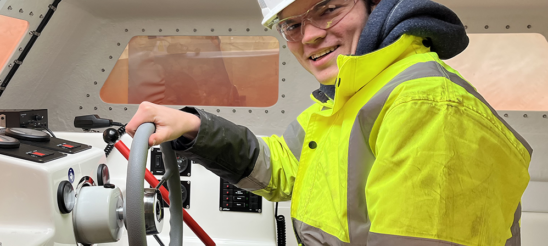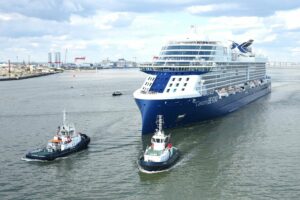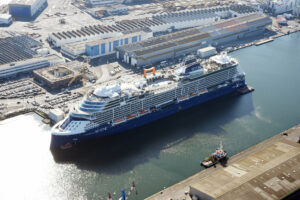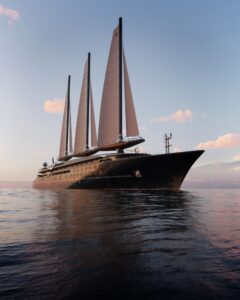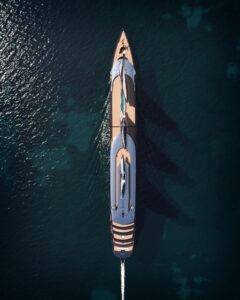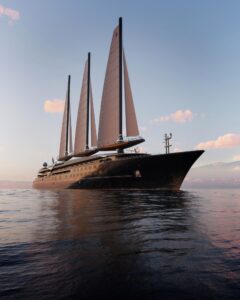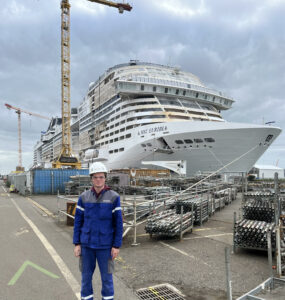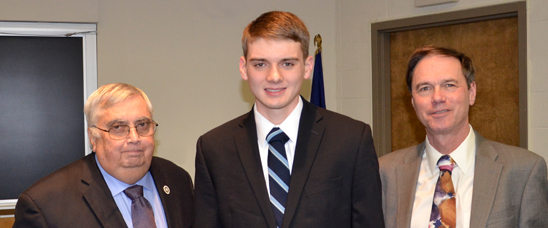Webbies are taking on their Winter Work internships fearlessly, and they have started a blog to share their experiences and insights with us.
The blog will cover a range of topics from the skills they have learned to the personal growth they have experienced throughout their time in the program.
Our first blog post is written by Paul Ferragu, a Freshman at Webb who is currently at the prestigious Chantiers de l’Atlantique for his Winter Work internship. Paul shows us that no matter where you are in life, with the right mindset, you can do anything and go anywhere.
Follow along with us on the journey!
Where are you working for the Winter Work term?
I’m spending my freshman Winter Work Term at the Chantiers de l’Atlantique in Saint-Nazaire, France.
Why are you interested in this company?
I was originally interested in this company because they design and build the world’s largest cruise ships for leading cruise lines and are at the front of innovation toward sustainable shipping. Although I don’t have a passion for cruise ships, their complexity is certainly fascinating. Everything I learn here will be applicable in almost every other sector of the industry. My personal favorite project they are working on is the Solid Sail.
How is the work environment?
I am part of an outfitting supervising team. I joined a team of 7 who specializes in supervising the outfitting of anything welded or attached to the metallic hull of the ship. This includes life-saving apparatuses, strategic fire-fighting equipment, mooring decks, hydraulic doors, machinery, and balconies. During my winter work term, I will be supervising the installation of some life-saving apparatuses.
What skills are you learning at the company?
I am learning technical French terminology and the logistics behind such a large and complex shipyard – there can be up to 8,000-10,000 personnel in the yard at a time and up to 4 ships under construction. There is activity 24/7 in the yard, and thousand-ton blocks are being lifted on an almost daily basis. I am also taking this opportunity to ask questions about the design process of ships. It takes 500 engineers and technicians to realize all the different ship’s plans fully. I am able to help my team with translating English to French and teaching them English terminology to ease their communication with contractors.
Why are you the best candidate for this internship?
I showed interest in learning from the world’s leading passenger ship shipyard and my French language skills enabled me to do my job in the language spoken daily within my team and with contractors. Some overseas shipyards can accommodate English speakers but that is not standard in French yards.
Where do you see yourself after this internship (or after graduation)?
As I am only a freshman, I will return to Webb after the winter work term to explore more sectors before deciding on one to pursue during my early professional career. I do hope to come back to this shipyard in my junior year to work in the design offices of their new sail and Liquified Natural Gas (LNG) -propelled ships.
Professor Daidola Gives Presentation at Joint Society Meeting Hosted by SNAME
This past June, Webb’s Assistant Professor of Structural Engineering, Dr. John C. Daidola, P.E., gave a presentation to local marine professional societies in New York City.
Professor Daidola’s presentation, entitled “A Cornucopia of Structural Challenges – Solved, Ongoing, Opportunities for the Future?” was eligible for 1 (PDH) PE continuing education credit, and was presented to members of the Society of Naval Architects and Marine Engineers (SNAME), the Eastern Branch of the Institute of Marine Engineers (IMarEST), the American Society of Naval Engineers (ASNE), and the Society of Marine Port Engineers (SMPE).
The presentation addressed a number of subject areas that have been identified as having merit for research and application to address important structural issues, sometimes historically recurring in different scenarios. Ten areas of interest were identified and discussed: IACS Common Structural Rules (CSR), Tanker Structure Behavior during Collisions and Groundings, Hull Stiffness Variation and Vibratory Response, Cold Zone Materials, Rouge Waves, Large Multi-Hull Vessels, Structural Considerations in the Producibility of Vessels, Naval Vessel Classification Rules, Offshore Industry Classification Rules and Reliability-Based Structural Design.
For more information on the presentation: SNAME June Joint Meeting
Webb Institute Announces Zeien Student Scholar
Webb Institute is proud to announce Jonathan Roussin, a member of the class of 2016, as the second Dr. and Mrs. Alfred Zeien ‘52 scholar. Dr. and Mrs. Alfred M. Zeien have generously established the “Dr. and Mrs. Alfred M. Zeien ‘52 Student Scholar” fund that enables Webb to provide a full-tuition scholarship and a $2,500 stipend to cover a portion of the student’s room and board expenses. Read more…

